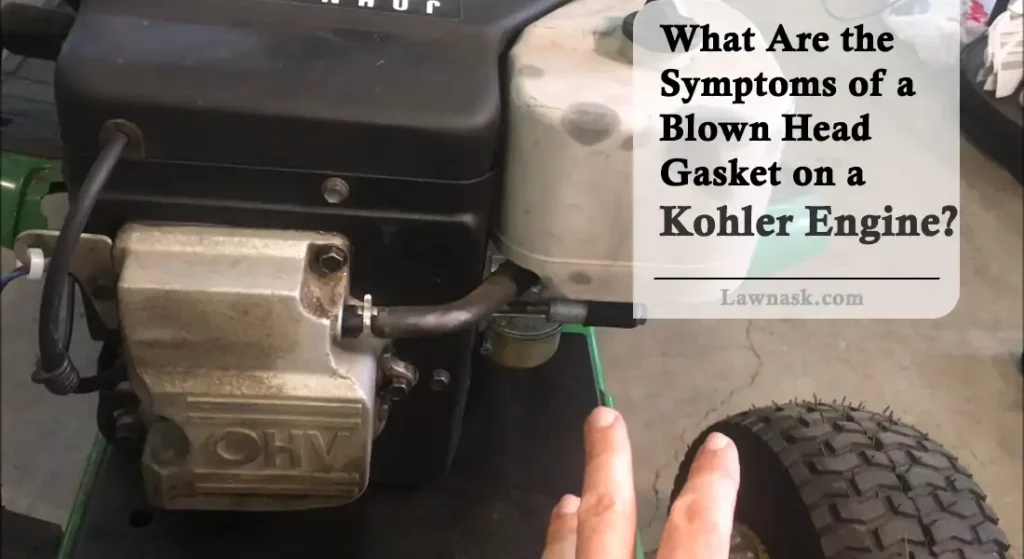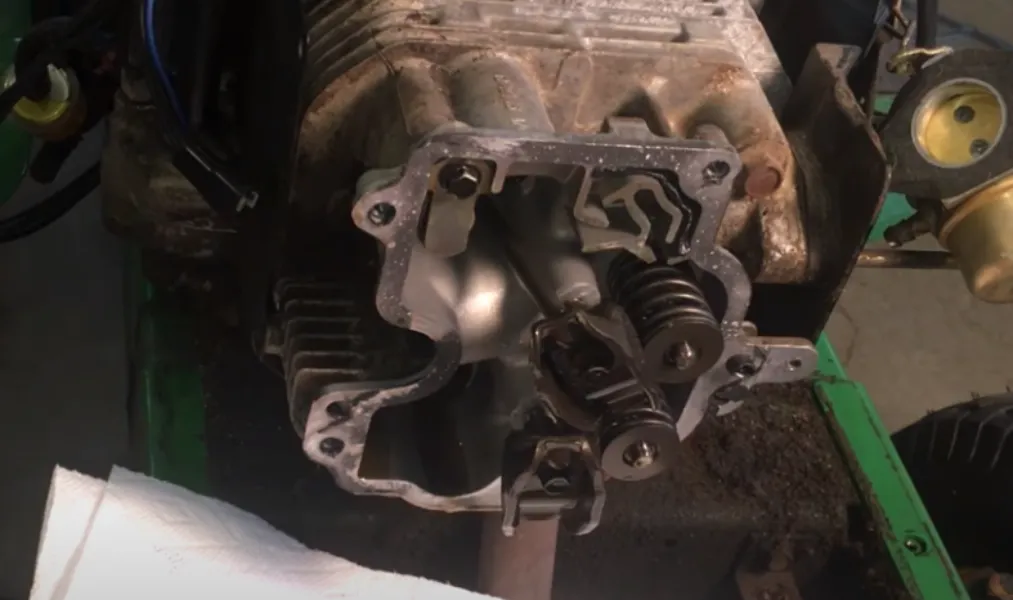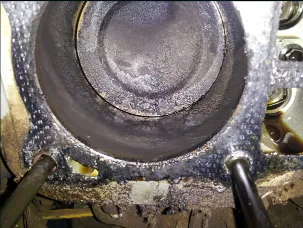What Are the Symptoms of a Blown Head Gasket on a Kohler Engine?
One common issue that can affect Kohler engines is a blown head gasket. But identifying a blown head gasket in a Kohler engine can be a challenge.
The symptoms can be similar to those of other engine problems. For example, engine overheating, loss of power, and white smoke from the exhaust can also be caused by a malfunctioning thermostat, a clogged radiator, or a faulty cylinder head.
Want to find out what are the prominent symptoms of blown head gasket on kohler engine? Find out below!

What is a Head Gasket?
A head gasket is an important internal component of the combustion engine. It seals the cylinder head to the engine block.
It is usually made of metal or composite materials and sits between the engine block and the cylinder head.
Although head gaskets are made to endure high temperatures and pressures, they can deteriorate or sustain damage over time.
How Does a Head Gasket Work in Kohler Engines?

Like any other internal combustion engine, function of the head gasket in Kohler engines is also similar. It joins the engine block and cylinder head.
A Kohler engine’s head gasket ensures that the cooling system is properly sealed. Which is where the metal or composite materials come in.
The gasket stops both the engine oil and coolant from mixing and from leaking into the combustion chamber.
It also endures thermal cycling, which happens as the engine heats up and cools down while running.
Common Symptoms Of Blown Head Gasket On Kohler Engine
A few specific symptoms appear when the head gasket is blown in your Kohler engine. Of course, go deeper by first taking off the valve cover and intake manifold to reveal the gasket head.

The symptoms are as follows:
- The engine chokes itself out with fuel or starves for air. There is a lack of pressure (a universal sign of a blown gasket).
- The engine smokes on first start up and when throttling down to shut it off. However, smoke is not noticeable while running.
- Some air loss out of the breather is normal as the rings never seal perfectly. However, if it comes out rapidly without pouring out the engine while running it, that is a problem.
- The engine burns oil like crazy. You will notice very poor fuel economy with a blown head gasket.
- The engine fouls one plug every few hours. But careful, sometimes it is not the head gasket, only some sealing valves. Do not believe any expert unless you have proof of it.
- The spark plug might be slightly crusted and black.
- If the head gasket is damaged, oil and coolant can mix, leading to a milky white appearance in the engine oil.
- A blown head gasket can cause an engine to misfire. You can feel a rough-running engine or noticeable vibrations.
- Look under the engine. You may find a couple of oil drops around where the muffler bolts to the head on the left side.
These are some of the prominent symptoms of a blown head gasket.
Read Also: Kohler Engine Runs Then Dies: What to Do?
Why Does a Head Gasket Get Blown on Kohler Engines?
A head gasket in a Kohler engine can get blown due to various reasons such as overheating due to cooling system defects, coolant leaks, insufficient lubrication, or even manufacturing defects.
The pressure and heat generated within the engine can cause the gasket to fail, resulting in engine damage and decreased performance.
Checking for a Blown Head Gasket: Tests and Procedures
A compression test and a leak down test can confirm a blown head gasket other than the visible signs. These are:
Leakdown Test:
For this test, you can use a cylinder leak down tester. But you can also check it with an air blowgun.
First, remove the valve cover. Bring the piston up to TDC on the compression stroke. Then secure the flywheel/crank (however you want to do it).
Then push a little air into the spark plug hole while listening for air in the pushrod galley and/or all around the outside of the head.
Compression Test:
Using a spark plug wrench, remove the spark plug from the engine. Insert the compression tester into the spark plug hole and tighten it down.
Hold the throttle wide open and crank the engine for at least five revolutions. Now note the compression tester gauge reading and write it down. Repeat the procedure for each cylinder in the engine and record the results.
Compare the compression readings to the manufacturer’s specifications for your engine model. If the readings are lower than the recommended range, it could mean that there is a problem with the engine’s valves, pistons, or rings.
The difference between compressions of each cylinder should not be more than 10% from each other.
False Alarm Check! : You should have your dealer check which flywheel is on the engine. Kohler had some problems with flywheel timing.
These engines have two different flywheels. A 22 degree and a 16 degree respectively. You must install an offset flywheel key if you have a 22 degree.
This issue has been linked to numerous head gasket failures. However, the offset flywheel key is only for CV and CH 730 engines.
How To Replace a Blown Head Gasket on a Kohler Engine?
The first step is to remove the engine from the equipment. So disconnect the fuel line, electrical connections, and any other engine-connected components.
Then disassemble the engine to access the cylinder head. The intake and exhaust manifolds, valve cover, and any other components that are blocking access to the cylinder head must be removed.
Next, unscrew the cylinder head bolts (should be four bolts) with a socket. Lift the cylinder head off. During this process, take care not to damage the head gasket or the cylinder head mating surface.
Now use a scraper or wire brush to clean the cylinder head and engine block mating surfaces. Because if your gasket is blown, you’d surely have gunk collecting. To ensure a tight seal with the new head gasket, remove all debris and old gasket material.
Install the new head gasket onto the engine block. Align the bolt holes and ensure it is properly seated.
Then carefully lower the cylinder head onto the engine block, making sure the head gasket and bolt holes are aligned. Install the cylinder head bolts according to the manufacturer’s torque recommendations.
Finally reassemble and reinstall the engine.
Read Also: 8 Most Common Kohler Engine Problems: How Do You Fix Them?
Costs of Repairing a Blown Head Gasket and Alternative Options
The first step is diagnosing a blown head gasket. This may involve a compression test, cylinder leak down test, or coolant pressure test. The cost for diagnosis typically ranges from $100 to $300.
The labor cost for a head gasket repair can range from $1,000 to $2,500, depending on the complexity of the repair and the location of the head gasket. This includes removing the cylinder head, replacing the head gasket, and reinstalling the cylinder head.
The cost of parts can range from $200 to $1,000 or more, depending on the make and model. If the cylinder head is damaged, warped, or cracked, it may require machine work. Such work as milling or resurfacing can cost an additional $100 to $500 or more.
Alternative Suggestions:
Engine Sealant: Some products, such as engine sealants, can be used to repair a blown head gasket temporarily.
These sealants range in price from $20 to $50. They may provide a temporary fix for minor head gasket leaks.
Engine Replacement: In some cases, replacing the entire engine may be more cost-effective than repairing the blown head gasket. These are for severely problematic gaskets due to the age of the engine or other factors.
Depending on the make and model of the vehicle, the cost of a new engine can range from $2,000 to $5,000 or more.
Frequently Asked questions (FAQs)
Can a blown head gasket be repaired in a Kohler engine?
Yes, a blown head gasket in a Kohler engine can be repaired, but it depends on the extent of the damage.
How often should the Kohler engine be inspected for potential head gasket issues?
It’s recommended to have your Kohler engine inspected for potential head gasket issues at least once a year.
What are the risks of driving a Kohler engine with a blown head gasket?
Continued operation of the engine with a blown head gasket can cause additional damage, potentially resulting in a more expensive repair or even engine replacement. It may also result in a seized engine.
Related Posts:
- Exploring the Company Who Makes Kohler Engines
- A Comprehensive Comparison of Honda and Kohler Engines
- Fixing the Problem of Oil Blowing Out from the Breather on a Kohler Engine
- Common Issues Faced by Kohler 27 hp Engines – What You Need to Know
- Addressing the 5 Most Common Problems in Kohler 24 hp Engines






